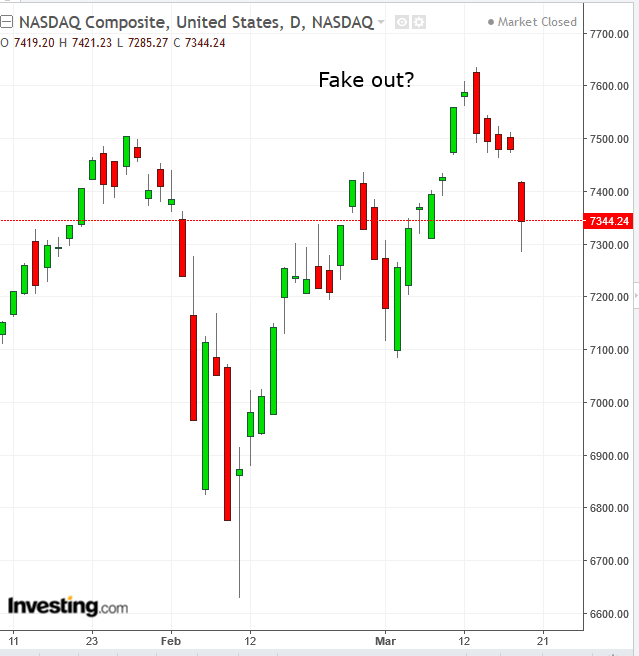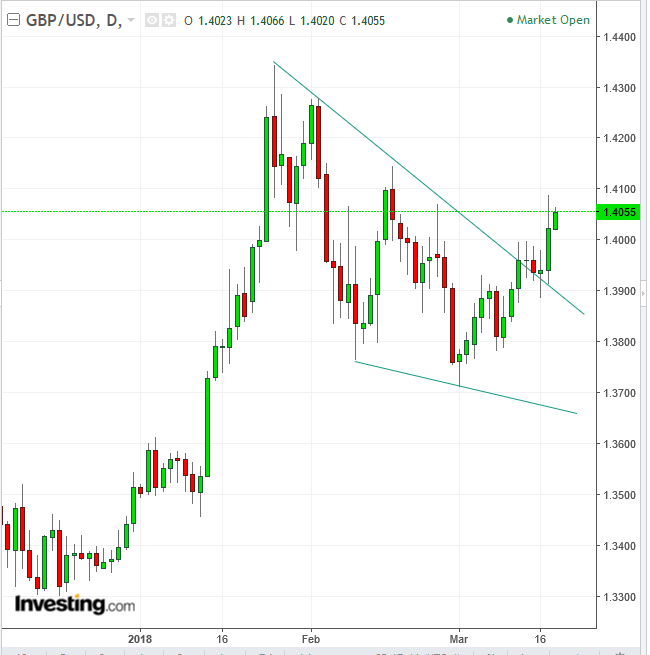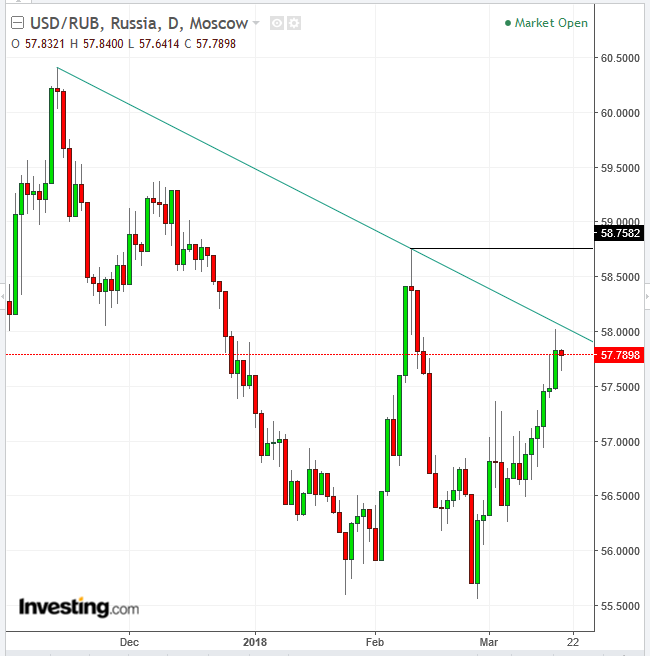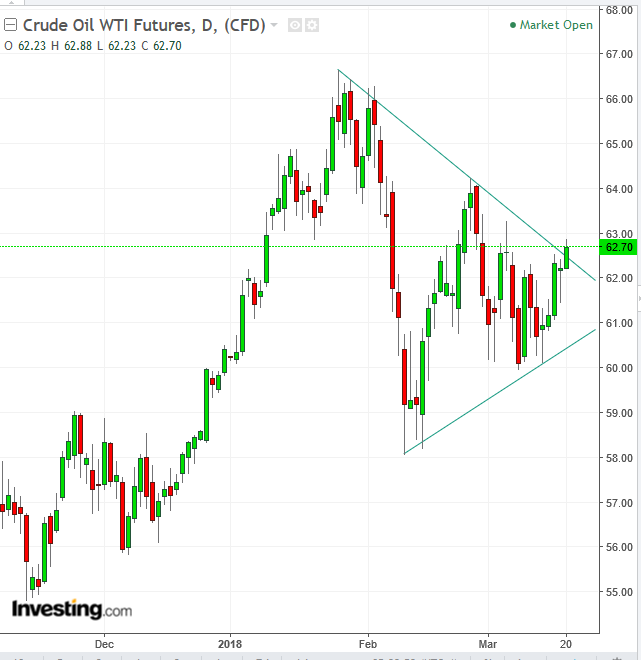-
Asian markets mixed
-
Europe's STOXX 600 gains ground
-
Trade war, Fed meeting in focus
-
Brexit deal boosts pound
-
Russian ruble falls on Putin's 'landslide' victory
-
WTI breaks through upper bound of range
Key Events
Global equity markets took a beating yesterday. In the US, NASDAQ indices were hit the hardest in six weeks, as fears that President Donald Trump is looking to fire special counsel Robert Mueller again raised the specter of political instability.

After the NASDAQ Composite hit a new record high on March 9, we pointed out that the lack of confirmation of its continued long-term trend via another major index could indicate that its rally was a fake-out. Is yesterday’s selloff proof of that? We're not convinced. Monday's price action does in fact appear to be a correction after the tech index posted a new high. A reversal with peaks and troughs pointing down would be a better confirmation that the recent highs were a false bullish signal.
News of Facebook's (NASDAQ:FB) data breach and Apple's (NASDAQ:AAPL) secretive development of its own next-generation screens sent tremors through the tech sector yesterday, and by extension prices across all major benchmark indices including the S&P 500, Dow and Russell 2000.
Facebook shares plunged nearly 7 percent following the news, and the stock scored its most significant drop in almost four years. The ramifications of heightened regulatory pressure in the aftermath of the social media giant's failure to protect user data could spill over to Google (NASDAQ:GOOGL) and Amazon (NASDAQ:AMZN). The two internet heavyweights have also attracted scrutiny over their data practices, which significantly contribute to their outsize earnings growth.
Big tech companies are already under pressure from the EU proposal that would hit them with a 3 percent tax on their gross revenues, based on user location.
Global Financial Affairs
This morning, stocks recovered across Asian markets: Japan's TOPIX managed to bounce off its daily low, while South Korea’s KOSPI and China’s Shanghai Composite inched higher. The Nikkei 225, however, closed lower.
European indices trimmed some of yesterday’s losses as the tech selloff eased, allowing almost every sector on the STOXX Europe 600 to climb into positive territory. Investor attention is now turning to the Fed's two-day monetary policy meeting, beginning tomorrow, Wednesday, while the fear of a looming trade war still plays on their minds.
Investor sentiment, however, seems to have stabilized after suffering a triple assault yesterday. The tech selloff occurred alongside worries that the Fed could hike rates four times this year and hints by David R. Malpass, the US Treasury Under-Secretary for International Affairs, that the US government may halt decade-long economic talks with China added to the overall instability, stoking the trade war flames.
Today's market climate seems to be dominated by a general trepidation over a possible faster pace of policy tightening by the Fed, which would force investors to re-consider their strategies.
Moreover, trade war headwinds were amplified by reports, late last night, that the US administration is preparing a $60 billion tariff “package” on Chinese imports. US Trade Representative Robert Lighthizer is in fact said to be carrying out an investigation that could lead to vexing measures targeted at the US's largest trading partner.

Sterling extended its rally for a straight third day, after the UK and the EU clinched a divorce deal on Monday. Technically, the pound completed a bullish Falling Wedge, suggesting prices are eyeing the 1.4400 level.

The Russian ruble ended a six-day slide, as the USD/RUB pair reached a downtrend line since November 15. An upside breakout of the 59.0000 level would complete a double bottom. The six-day straight loss followed the 'landslide' victory of President Vladimir Putin on Sunday in what was considered a tightly controlled election.

The price of WTI crude penetrated the upper bound of a symmetrical triangle. A decisive upside breakout would signal a continuation of the trend prior to the interruption, upward.
Up Ahead
-
Headline UK inflation may have slowed to 2.8% in February with the core rate easing to 2.5%.
-
The Fed decision and Chairman Jerome Powell’s news conference come on Wednesday.
-
The Trump administration could impose trade tariffs on China as soon as this week.
-
The Bank of England is expected to hold interest rates and its asset-purchase program unchanged on Thursday. Attention will focus on language and the odds for a hike in May.
-
FedEx (NYSE:FDX) is scheduled to release earnings for the fiscal quarter ending February 2018, with a $3.06 consensus EPS, versus $2.35 for the same quarter last year.
- Dropbox's (NASDAQ:DBX) much-anticipated IPO is scheduled for this Friday.
Market Moves
Stocks
-
The STOXX Europe 600 Index increased 0.1 percent.
-
S&P 500 Futures were unchanged at the lowest level in more than two weeks.
-
The MSCI Asia Pacific Index declined 0.2 percent to the lowest level in more than a week.
-
The UK’s FTSE 100 rose 0.3 percent.
-
The MSCI Emerging Market Index rose 0.3 percent.
Currencies
-
The Dollar Index declined less than 0.05 percent.
-
The euro increased less than 0.05 percent to $1.234.
-
The British pound jumped 0.3 percent to $1.4062, the strongest level in more than a month.
-
The Japanese yen dipped 0.3 percent to 106.41 per dollar.
-
South Africa’s rand rose 0.3 percent to 11.9854 per dollar.
-
The MSCI Emerging Markets Currency Index rose 0.1 percent.
Bonds
-
The yield on 10-year Treasuries rose one basis point to 2.86 percent.
-
Germany’s 10-year yield rose one basis point to 0.58 percent.
-
Britain’s 10-year yield gained two basis points to 1.445 percent.
Commodities
-
WTI crude rose 1 percent to $62.66 a barrel, the highest in three weeks.
-
Gold decreased 0.1 percent to $1,314.88 an ounce.
-
The Bloomberg Commodity Index gained 0.2 percent.
